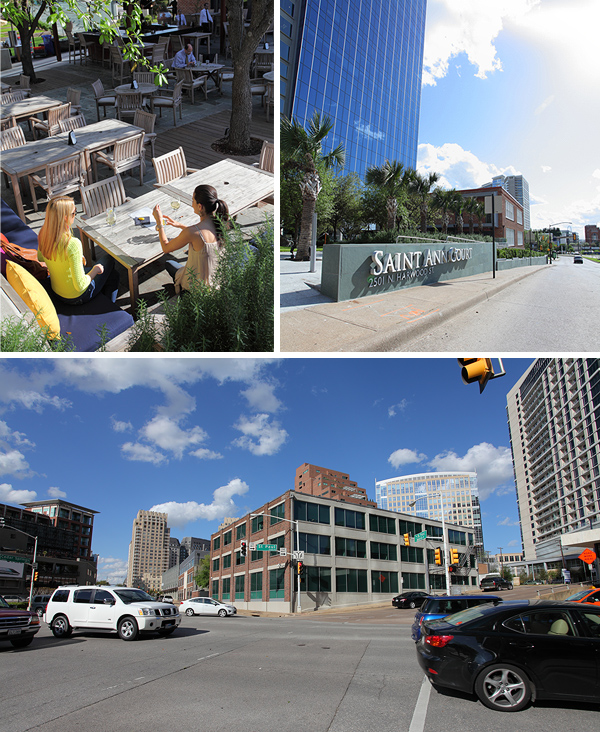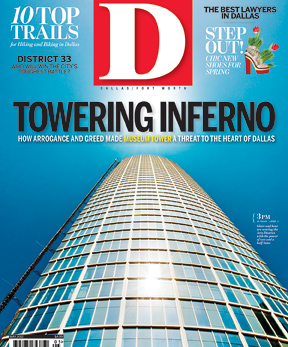A few weeks ago, I took part in a panel discussion held at the Dallas Center for Architecture, which graciously provided beer. After unsuccessfully arguing that neon lights alone do not make a great city and that Dallas needs a more serious discussion about the dynamics that produce memorable places instead of just superficial eye candy (“glib ephemeralities,” as Lewis Mumford put it), I realized that all my yammering had kept me from taking advantage of my host’s hospitality. Another beer was in order. A friend of mine, Kevin Buchanan, who writes about urban issues on his Fort Worthology blog, had come to the event. He suggested we walk. Uh-oh.
The Dallas Center for Architecture office is in the Lower McKinney (LoMac, if you must) area of Uptown. Over the past decade, a number of high-end office and residential towers have sprung up there. All the buildings—the Azure, the Ritz-Carlton, etc.—make attempts at something approaching good urban design, yet none actually achieves it. Height may mean density but not necessarily. And density may be urban but not necessarily. They are functionally suburban in nature. Residents park beneath the towers and never set foot in unconditioned air. Nobody would be caught dead actually walking on the streets below their penthouse. The roads are designed to move cars and do so quickly.
I suggested we go to the lovely Saint Ann on North Harwood. We had only four blocks to walk, but it seemed much longer. My poor friend Kevin became disoriented and bewildered by the game of human Frogger I’d dragged him into. There was little to see other than headlights, no “pedestrian propulsion,” the phenomenon shopping malls copied from historic main streets where storefronts engaged the sidewalk, shortening perceived distances.
Eventually, we did make it in one piece to Saint Ann. I highly recommend it. I’m particularly fond of how the historic two-story brick St. Ann’s Parochial School was renovated to create an oasis in LoMac. On a pleasant evening, you can enjoy a cocktail with friends by a fire pit in the garden nestled between the restaurant and the Saint Ann Court office building. It is a gorgeous example of blending the historic and the modern. You’ll appreciate the way the dining terrace and garden integrate with the school-turned-restaurant-and-museum and the lobby of the modern office building. It’s a great example of Dallas’ ambition to reurbanize, an isolated instance of human-scaled detailing best viewed with blinders so as to ignore the surrounding nasty thicket of curving, disorienting streets designed by people with no apparent
concern for the well-being of the city.
The market value of places derives from their desirability. People want to be there. Instead, LoMac is judged and valued by what is inside the buildings rather than what is outside of them: granite countertops and Sub-Zero refrigerators but no neighborhood that might, if needed, substitute for your dining room. The appliances are nice, but their value is ephemeral. The buildings recoil upward from ridiculously narrow sidewalks unbuffered from the high-speed streets, forming cul-de-sacs in the clouds, separated from the city below as if the residents are allergic. As they should be. As am I to becoming a hood ornament of a Yukon.
Look at desirable neighborhoods in cities around the world: L’Eixample in Valencia, Spain; the Upper East Side in New York; or pick an arrondissement in Paris. Though the dwellings are exclusive, the sidewalks and streets are not. Even if the shops are unaffordable, the streets are still a nice place to stroll. Since the design and feel of LoMac don’t invite street life, I suspect the value of the homes and properties in it won’t last. If I had money tied up in the area, I’d either get it out fast or pass around the hat to other investors with the awareness that one block does not a walkable, desirable place make.
On our way to Saint Ann, we passed the ugly, forboding entry ramp to the parking garage for the adjacent office building, Saint Ann Court. Painted on a wall was a quote from Winston Churchill: “First we shape our buildings; thereafter, they shape us.” I couldn’t tell if the designer who put the quote there was clueless or brilliantly ironic. I posted a picture of the wall on Twitter, and someone wrote sardonically: “If these buildings shape us, is it any wonder the shape we’re in?” A comment on our sedentary lifestyle or our current development-induced economic malaise. The joke works either way.
Write to [email protected].






